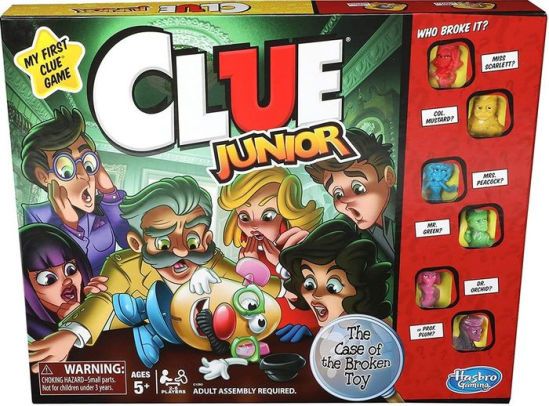Clue Junior: The Case of the Broken Toy (2018) Board Game
Clue Junior: The Case of the Broken Toy is a children’s version of the classic Clue board game. It was released in 2018 by Hasbro, designed for players aged 5 and up. In this version of the game, players take on the roles of child detectives trying to solve the mystery of the broken toy.
Game Components of Clue Junior: The Case of the Broken Toy
How To Setup Clue Junior: The Case of the Broken Toy
To set up the game, place all the yellow bases facedown on the table, mix them up, and randomly pick one to place in the middle of the gameboard; this base indicates the time the toy was broken. Randomly select a furniture token for each yellow base without looking at the bottom, and place each token in its corresponding room on the gameboard. Set aside the white base with the toy box and randomly place another white base in the middle of the gameboard to represent the broken toy.
Gameplay Mechanics and Game Objective
– Roll the die to determine your action: rolling yellow lets you inspect a furniture token to learn the time the toy wasn’t broken, rolling white lets you inspect a character pawn to see which toy is pictured, and rolling a number allows you to move your character pawn.
– Mark off information on your detective notepad.
– Solve the mystery by guessing the toy, the character responsible, and the time of the incident.
Player Experience
**Clue Junior: The Case of the Broken Toy** offers a simplified yet engaging version of the classic Clue game, tailored for younger children. The game enhances deductive reasoning and problem-solving skills as players gather clues and eliminate possibilities. The use of a detective notepad helps kids keep track of their findings, making the game both fun and educational.
Pros
Cons
Personal Thoughts on Clue Junior: The Case of the Broken Toy
This game is perfect for families with young children who are looking to introduce their kids to deductive games in a fun and accessible way. It’s an excellent tool for teaching critical thinking and problem-solving skills while providing an entertaining experience. However, as children grow older, they might find the game too simplistic and may require more complex challenges.
We are supported by our audience. When you purchase through links on our site, we may earn an affiliate commission, at no extra cost for you. Learn more.

